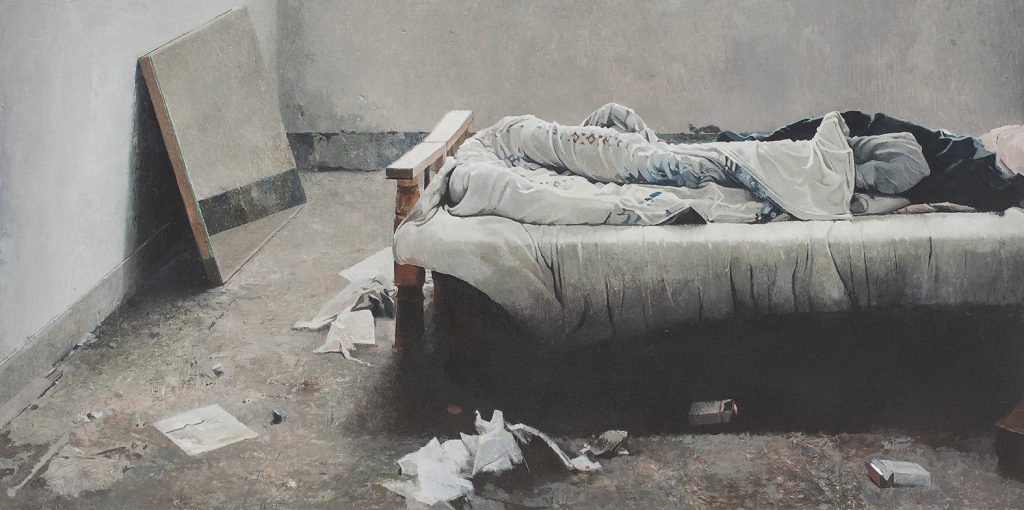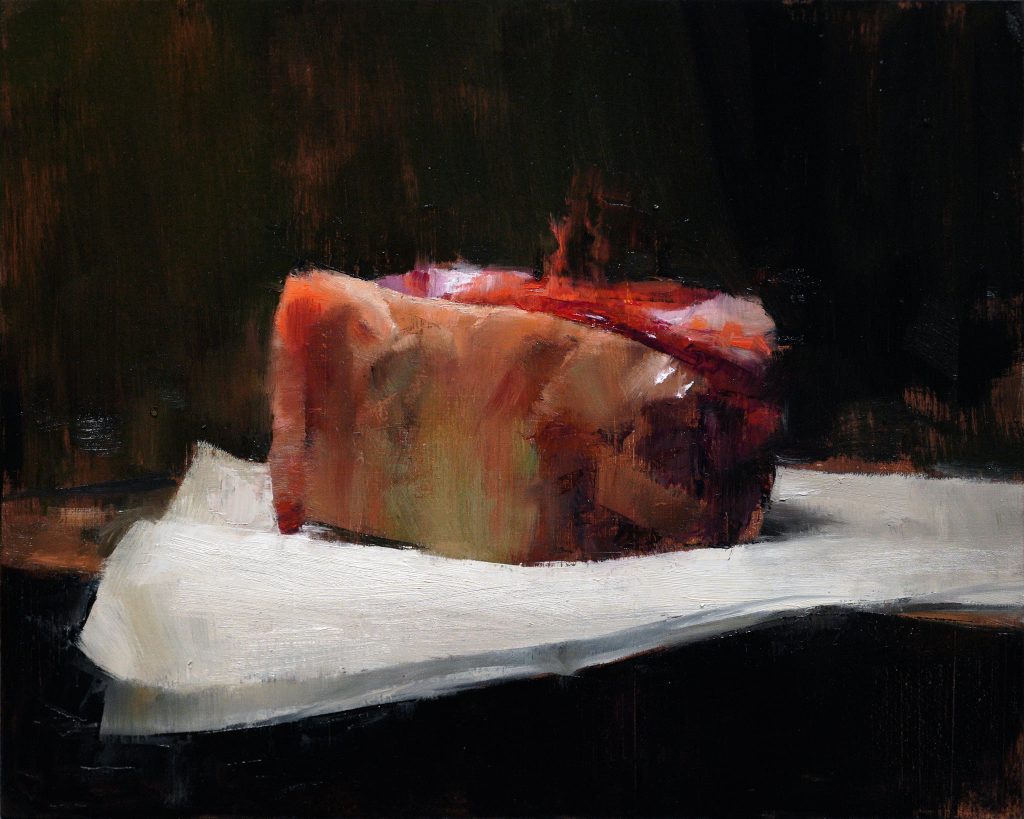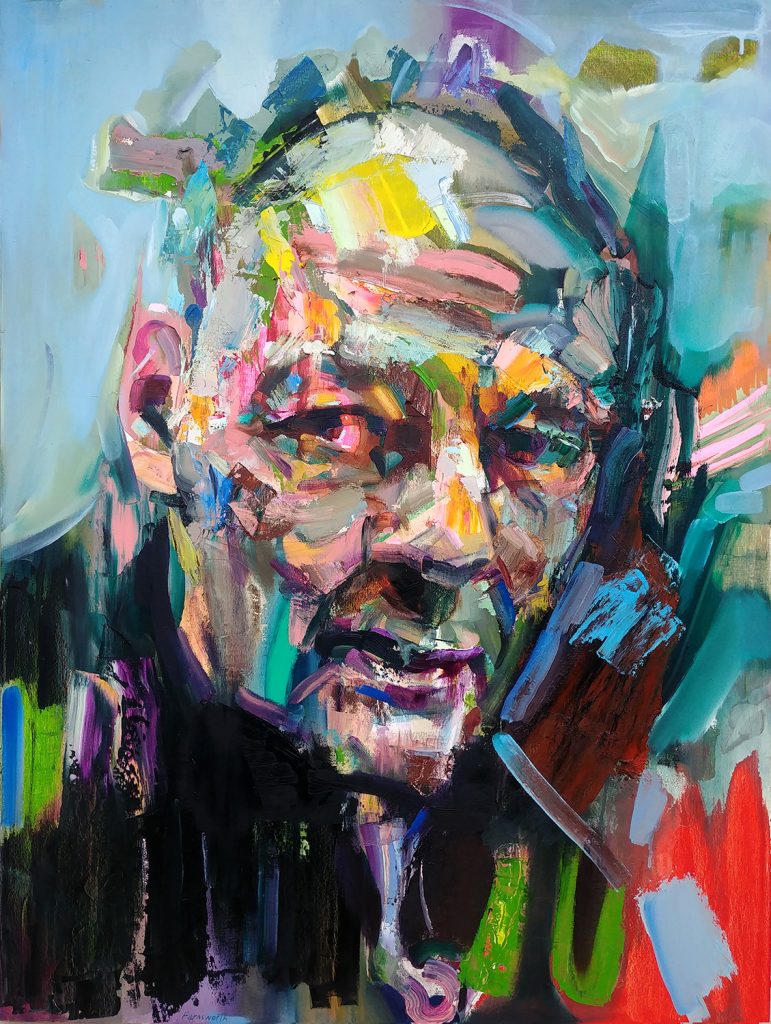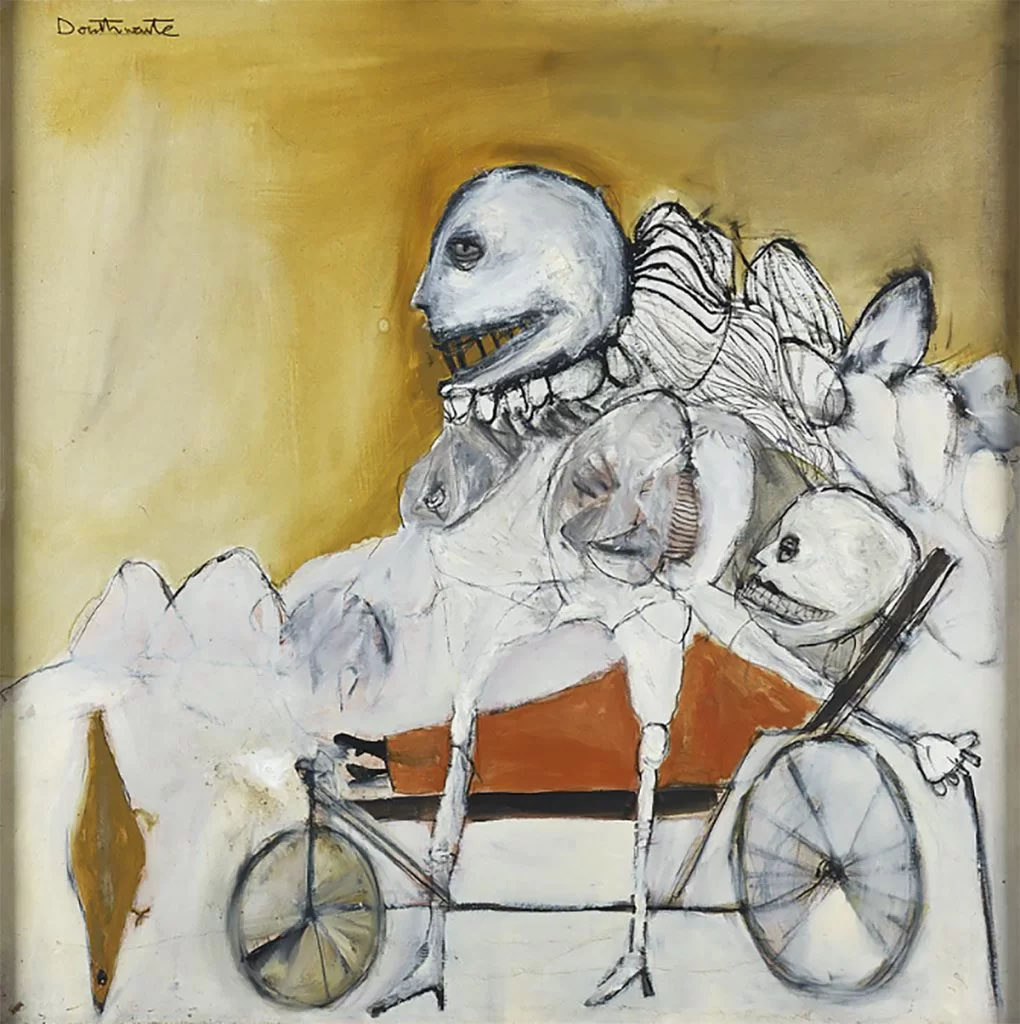In: painters

Joseba Sánchez Zabaleta | Room With Mirror
September 8, 2023Joseba Sánchez Zabaleta | Room With Mirror
“It is said that scattered through Despair’s domain are a multitude of tiny windows, hanging in the void. Each window looks out onto a different scene, being, in our world, a mirror. Sometimes you will look into a mirror and feel the eyes of Despair upon you, feel her hook catch and snag on your heart.
—————————————
In her world, there are so many windows. Each opening shows her an existence that’s fallen to her — some only for moments, some for lifetimes.”
(Neil Gaiman, from Season of Mists and Brief Lives, respectively)
Part of a larger series that engages with ‘footprints and memory’ and places now empty where the artist has recorded – or interpreted – the detritus of those who once existed in these spaces, Zabaleta’s paintings seem haunted. Though empty of people, their presences still suffuse the space, with an implication of absence, with someone missing that still is intrinsic to the atmosphere of his compositions.
His words : I wanted to paint the uninhabited buildings that I found in search of the memory of all those lives that I sensed should remain intact and detained in them. Waiting for something to happen, the empty buildings keep within their walls the trace of what has been lived between them. Somehow the fled love is imprinted on the plaster of its partitions. The silence of those deaf rooms falls through the walls, depositing itself between the joints in the pavement, next to the arid and dusty trace of time, among accumulated fragments, piled up by the wind in the corners.
One of the images I’ve shared in the full post is titled Marlom. Zabaleta offers the following meditation about this site, this painting, and the unknown person :
Of you there is only a name written in blue blood.
You thought it would be easy, that it would be just as they had told you. You thought that if others had achieved it, you would also achieve it. You thought while you were hiding, while the world was chasing you, what would be the best way not to be seen, to disappear, and you didn’t realize that nobody saw you, that you could have gone out on the road and walked, because those who are like you around here and you don’t look at them nor do you see them.
More of Joseba Sánchez Zabaleta’s fine paintings can be seen here.
~ Bart Gazzola
Read More
Scott Conary | Lamb on Paper, 2023
April 20, 2023Scott Conary | Lamb on Paper, 2023
Flesh is our indisputable commonality. Whatever our race, our religion, our politics we are faced every morning with the fact of our bodies. Their frailties, their demands, their desires. And yet the erotic appetites that spring from – and are expressed through – those bodies, are so often a source of bitter dissension and division. Acts that offer a glimpse of transcendence to one group are condemned by another. We are pressured from every side – by peers, by church, by state – to accept the consensual definition of taboo; though so often what excites our imaginations most is the violation of taboo. (Clive Barker)
Meat, weeds, eggs, bottles, and bones. What began as a way to get back to the basics of painting, without an agenda, became something else. The meat paintings are, understandably, the pieces that elicit the most questions. The first is usually, “Why meat?” The glib answer is “you can only paint so many pears.” The longer answer is that the meat is beautiful and somewhat evocative. We have a much more complicated reaction to a hunk of lamb than we do to pepper. The meat is the stuff of us. We are, after all, meat. The smell shifts while I work. The color changes. I have vivid memories of meals with family and friends built around meat. It’s beautiful, desirable, and it’s unclean. (Scott Conary)
At a very young age I encountered Alina Reyes’ novel Le Boucher [The Butcher] : consider that your only warning, before you proceed.
Let us talk about meat, about the way of all flesh, about the grotesque and evocative history of painters and photographers offering us a sense of the sensual and the shocking.
Ah, but before we get to that I must say that when I encountered Scott Conary’s work on one of my social media feeds, I was struck by it’s beauty and execution (I was unsurprised it’s painted in oils, as there’s a sensuality to that medium) and it sent me on a deeper exploration of his works.
His words also acknowledge that this choice of subject matter is neither new nor to be eschewed. Many artists have employed this trope to investigate or confront larger issues: Chaïm Soutine’s Carcass of Beef, or Rembrandt van Rijn’s Slaughtered Ox, function both as still lives – though I might use the French term of nature morte, here – but also as metaphors, whether for religion, suffering, violence or our own ongoing obsession and repulsion with our own physicality.
Conary’s renderings of meat and flesh – like many of the artists whose works I’ve shared in this post – are inappropriately beautiful.
But that beauty is tendered by how it is often metaphor, as well. One of the works I share below by Ilya Mashkov, considering the date of its execution during the Russian Civil War, is a commentary that evokes the words of his contemporary, Boris Pasternak, where his character Zhivago, speaking to the local commissar (after examining a dying man) sardonically avers that “It isn’t typhus. It’s another disease we don’t have in Moscow…starvation.” Andres Serrano‘s Cabeza de Vaca references a Spanish ‘explorer’, presented as plunder instead of plunderer, and Mark Ryden’s Meat Dress offers something for us to visually consume that explores some of the same ideas as Jana Sterbak’s Vanitas: Flesh Dress for an Albino Anorectic (which I’ve written about before) but in a more palatable form, perhaps.
Two more artists to share, that expand the conversation around Scott Conary’s meat works (I want to type that as one word – meatworks – as that seems more viscerally appropriate): Victoria Reynolds‘ art also offers “an uneasy tension between the understanding of flesh as food, and our self-identification of it; her conflation of desire, mortality, viscerality, and the survival instinct is a powerful source of aesthetic fascination.” Kanevsky, on the other hand, is primarily a figurative artist, as an American with heavy Eastern European influences. When you look at more of his work, and his preference for nudes, you may be forgiven for thinking that the work below is just painting the interior, instead of the exterior, of his ‘models’….
More of Scott Conary’s work can be seen here and his IG can be found here. His practice – and choice of subject matter – is quite varied (I was simply seduced by his meat works, if you will, but I did consider using his interpretations of eggs as a basis for a curator’s pick, as well) and worth exploring.
~ Bart Gazzola
Read More
Geoff Farnsworth | Frank Auerbach, 2021
April 13, 2023Geoff Farnsworth | Frank Auerbach, 2021
But this rigour could be seen as revolutionary, one requiring a major historical shift from an art of representation to one of presence, that is, the direct experience of the object standing before you.
Julian Bell, What is Painting? Representation and Modern Art
Let us begin with a disclaimer that is, in fact, a compliment. I am not featuring my friend and the fine painter Geoff Farnsworth’s work because he has painted me twice (he has rendered, wonderfully, in paint, a number of denizens of Niagara), nor because the most recent of these is almost perfect in capturing the moment and conversation we were having (he snapped a picture at that time) and the vagaries of my overly expressive face and demeanor. I won’t tell you what we were discussing at the time (along the road in Welland) but my unimpressed face in that work tells you all you truly need to know, of the moment.
Farnsworth has demonstrated that ability on numerous occasions, to not only bring a telling likeness of his subjects into his paintings, but also to seemingly embed an element of their personality, too. A fine painter who dances between figurative works and hints of abstraction with an affinity for colour that defines his art.
His portraits seem to coalesce from his thick, mucoid paint, with a figure emerging from his rich colours and almost sculptural application of his medium. The image vascillates between abstraction and representation, and in this work – as it is a portrait of the painter Frank Auerbach – that dialogue happens not just on the canvas but in the conversation around the choice of subject, and Auerbach’s own ideas regarding non representational and more ‘realist’ painting. But – somewhat in opposition to this idea, as all these things blend together like paint on a surface – I’ll return to Julian Bell, whom I cited at the beginning of this essay: ‘ — there was no prior context to the painting itself. The viewer’s eyes would submit, and the painting would act.’
But let’s end by returning to Auerbach (from Frank Auerbach Speaking and Painting by Catherine Lampert): “Auerbach views such claims and labels as essentially meaningless; for him, where figurative art excels, if it is any good, is in what is abstract within the painting and concept. The forms one engages with, and invents, will have a plastic character and individuality unconnected to their names.”
Since I mentioned it in this article, I feel compelled to include an image of the fine portrait that Geoff Farnsworth painted of me, so you might have a visual to augment my words. But I will temper it with an image from Ad Reinhardt, whose ideas about the immediacy of the art object, and the necessity of its primacy in any interpretation of the same is relevant to considering Farnsworth’s portraits, which shift and flow and fracture and come together again, all in colour and line and very physical, goopy ways. Both of these can be seen in the proper post for this artist, not on this front page.
Geoff Farnsworth began his art training in Vancouver, B.C. at the Federation of Canadian Artists, Emily Carr, and Capilano College in the Graphic Design & Illustration Program. He moved to New York City to train at the Art Students League from 1997 to 2002. His paintings have been shown in New York City, Washington DC, Minneapolis, Toronto, Vancouver, Winnipeg, Thunder Bay, Niagara Falls, Norway, Sweden, and Trinidad.
His words: “My paintings explore a relationship between figurative and abstraction in order to meld unconscious probing and stylistic innovation with a meditative figural base. It is important to me that the paintings work well as collections of shape, colour, texture, and energy, while also building a compelling image. Working with people and objects from my personal world, I focus on maintaining a balance between plan and accident, known and unknown, restraint and exuberance. My figures look out as much into mindscape as landscape.”
You can enjoy more of Farnsworth’s work here and more of his portrait works (of people both known and more local) can be viewed here.
~ Bart Gazzola
Read More
Pat Douthwaite | Bernard Berenson at Leptis Magna, 1966
March 31, 2023Pat Douthwaite | Bernard Berenson at Leptis Magna, 1966
I am only a picture-taster, the way others are wine – or tea – tasters.
Bernard Berenson
Years ago when I was on a panel talking about ‘modernism’ I offered a line from Clement Greenberg, that is one of my favourites (not solely for the idea expressed, but also as it seemed to fly in the face of many of the karaoke modernists who attended that discussion on the prairies who are sure ‘art’ ended with hard edged painting several decades ago): that we evaluate artwork with the criteria we have now, but fully understanding that this criteria can and must change.
Greenberg is one of the ‘old gods’ of the Western art canon – like Bernard Berenson, the erstwhile subject of this painting by Douthwaite. The site that Berenson is ‘visiting’ in this painting is of significant archeological important (more on that can be read here). Berenson (1865 – 1959) was an American art historian specializing in the Renaissance, but his influence was much more than that, and he is one of the shoals of Western art history that is to be negotiated.
But – in deference to contested narratives, and considering how Douthwaite has, like too many female artists, not garnered the acclaim of some of her male colleagues – I also offer Atwood’s iconic line: “We were the people who were not in the papers. We lived in the blank white spaces at the edges of print. It gave us more freedom. We lived in the gaps between the stories.” Douthwaite’s paintings have a striking originality, and though she’s often compared to Chaïm Soutine he is also – like Douthwaite – an artist whose work is immediately recognizable. This painting has a carnivalesque quality to it, and the ‘skulls’ suggest a merry dance of death…. she often “referred to herself as the “high priestess of the grotesque”, aptly describing her dedication to the arresting, often haunting, figurative work that carved out her place within British postwar art…[Douthwaite] was a distinctive and complex artist rather than [simply] a “difficult” woman, as she was sometimes described.” (from here)
Douthwaite’s approach is unique: ‘Instead of the traditional easel set up, Douthwaite preferred to paint on the floor: ‘I crawl around the floor on my knees, with a butcher’s apron round me, moving from drawing to drawing or canvas to canvas.’ She was unconventional in her painting technique too and rather than use brushes she worked the images up from the surface of the canvas using paint-soaked rags. She often depicts death with humour as if to underline the absurdity of life.’ (from here)
Pat Douthwaite was born in Glasgow in 1939 and initially studied mime and modern dance with Margaret Morris. She is primarily self taught, though in 1958 Pat lived in Suffolk with a group of painters. From 1959 to 1988 she travelled widely (North Africa, India, Peru, Venezuela, Europe, USA, Kashmir, Nepal, Pakistan, Ecuador) and from 1969 lived part of the time in Majorca. Douthwaite exhibited with the Women’s International Art Club in London between 1960 and 1966. She returned to spend the rest of her life in Scotland, passing away in 2002 at Dundee. In 2005 the Scottish National Gallery in Edinburgh mounted a memorial exhibition to mark her life and work.
Much more of her work can be seen here, and more about her life can be learned here.
~ Bart Gazzola
Read More
Shani Rhys James | Woman Smoking, 2011
March 7, 2023Shani Rhys James | Woman Smoking, 2011
“If painting doesn’t offer a way to dream and create emotions, then it’s not worth it.” (Pierre Soulages)
“Through the dialogue between paint and word, issues of domesticity, rootlessness and the relationship between women and the home will arise within the claustrophobic space, revealing how the places in which we live can say so much about who we are.” (Karen Price, from here)
There is a directness to James’ paintings – her moments that are both captured and created – of everyday, potentially ordinary scenes that is belied by her facility in paint. The physicality of the medium as employed by James’ is reminiscent of Lucian Freud (“She lathers and slathers on the paint with a kind of unrestrained glee” asserts Michael Glover), and the charged nature of what she presents to us is of the same ilk. Something has just happened, or is about to happen: there’s a quietus here, portentous and mildly unnerving.
The tight compositions of figures in rooms that seem suffocating were also a factor in the many works that James made about life during COVID lockdowns: “The claustrophobia of the interior is a metaphor for that frustration of being unable to express deep feelings of creativity, or to be involved in pertinent worldly issues.”
James also offers – not about this painting specifically, but applicable here that “my over-scaling of flowers [in the wallpaper] evokes either a cloying or menacing atmosphere, both repellent and seductive.” (from here)
Shani Rhys James is originally from Australia, but has lived and worked in Wales for since 1984. A more complete history can be read here.
If I may inject a touch of subjectivity, with the disclaimer that my mind often goes to dark places: when looking upon James’ people, I was reminded of an exchange in Margaret Laurence’s The Diviners, where the painter Dan McRaith finally shares some of his work with the main character Morag Dunn. McRaith figures, in the Gunn’s initial response, have ‘eyes [that] seem distanced, distorted–no, not distorted; the flesh mirrors the spirit’s pain, a greater pain than the flesh even if burned could feel. A grotesquerie of a woman, ragged plaid-shawled, eyes only unbelieving empty sockets, mouth open in a soundless cry that might never end, and in the background, a burning croft. Morag turns and looks at him, after looking at this last painting. “The dispossessed.”’
“Shani Rhys James is arguably the most exciting and successful Welsh painter of her generation. Her considerable reputation, both in Wales and beyond, continues to grow apace. She has exhibited with Martin Tinney Gallery since 1993 and subsequently her work has appeared in exhibitions throughout Britain and mainland Europe. William Packer, the distinguished art critic, has spoken of her as a painter of remarkable power, whose paintings are as convincing as anything currently being produced in Britain.” (from here, where you can see more of her fine works and learn about her many accomplishments)
Shani Rhys James’ site is here. She can be found on IG here.
~ Bart Gazzola
Read More
Recent Comments